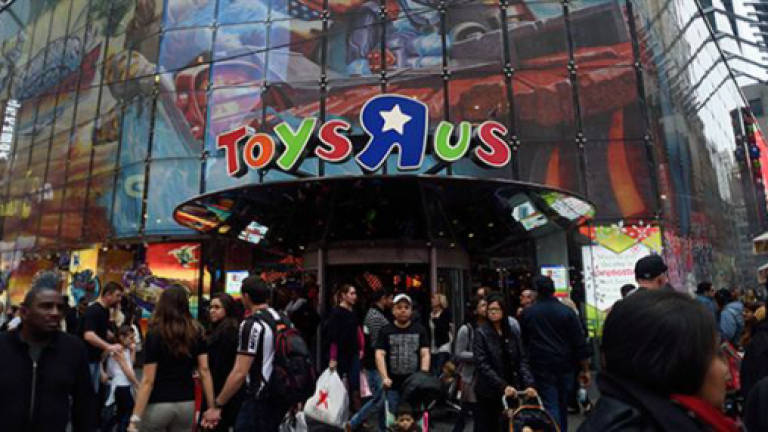A cautionary tale for Malaysians

ON Sept 18 this year, iconic toy chain Toys 'R' Us – with a combined 1,600 Toys 'R' Us and Babies 'R' Us stores worldwide – filed for bankruptcy.
A Chapter 11 filing does not mean a company will be wound up; the best known survivor of a bankruptcy filing is auto manufacturer General Motors. However, Toys 'R' Us faces a daunting list of problems – a Himalayan level of debt, intense competition, a flawed marketing strategy in 2000 and a drastic change in children's playtime preferences.
On a broader front, Toys 'R' Us also highlights the downside of the online retailing phenomenon in the US economy that Malaysian policy makers would do well to study.
Superficially, the toy store appears to be the latest victim of a competitive onslaught by online retailers. In the first six months of 2017, more than 20 retailers in the US filed for bankruptcy with thousands of stores closing, Tonya Garcia wrote in Market Watch.
This year could be the worst for American retailers. Credit Suisse believes 8,640 stores could close this year – surpassing the peak of 6,200 closures in 2008, Anne D'Innocenzio writes in Associated Press.
While online behemoth Amazon was a factor in decimating sales at Toys 'R' Us, deeper analysis suggests the toy retailer was ultimately felled by massive debt.
In 2005, a US$6.6 billion leveraged buyout (LBO) orchestrated by Kohlberg, Kravis & Roberts (KKR) and Bain Capital saddled Toys 'R' Us with annual interest payments of US$450 million – this was more than double the toy retailer's then net profit, Adam Hartung wrote in Forbes.
Crushing debt deprived Toys 'R' Us of the needed financial resources to invest in up-to-date technology and marketing to compete with rival retailers, both online as well as brick-and-mortar. Amazon provides convenience and a bigger selection of toys – five million compared with less than 100,000 at Toys 'R' Us – while Walmart's Jet.com offered the lowest prices.
Two tectonic shifts also upended Toys 'R' Us. First, 13.7% of toy sales were made online in 2016, more than double the 6.5% share five years ago, GlobalData Retail says.
Compounding the problem was a short-sighted decision in 2000 by Toys 'R' Us to sell toys online via Amazon – an arrangement terminated in 2006 after the online giant in 2003 started selling, on its website, competitors' toys and baby products.
Although Amazon paid US$51 million to Toys 'R' Us to settle the subsequent lawsuit, this outsourcing arrangement left the toy retailer a very late starter to online marketing.
"The fact that Toys 'R' Us ceded control of its own online offering to Amazon during a period where e-commerce began to really take off meant that the retailer was always playing catch up with its online competitors," wrote Jon Copestake, chief retail and consumer goods analysts at the Economist Intelligence Unit.
Second, an increasing number of children abandoned traditional toys like Barbie and Ken dolls, action figures, puzzles and board games for smartphones and tablets.
A 2014 study by child-education specialists, the Michael Cohen Group, indicated more than 60% of parents said their children aged 12 or younger play on touch screens "often" while 38% do so "very often".
Even among toddlers less than two years old, 38% have used a mobile device compared with just 10% two years ago, another survey of 1,463 parents by Common Sense Media suggests.
A study by the American Academy of Pediatrics (AAP) found among families with children eight years or younger, there was a five-fold jump in tablet ownership – from 8% in 2011 to 40% today.
Not only did e-commerce's accelerating growth undermine toy sales at Toys 'R' Us, it also seriously eroded the value of its real estate. In the 2005 LBO, KKR and Bain had assumed cash could be raised to meet interest payments by selling Toys 'R' Us retail stores.
"But as online retail grew, and traditional retail declined, America became "over-stored" with far too much retail space. Prices were shattered in many markets, and it was not possible for Toys 'R' Us to sell those assets for a gain that would meet the debt obligations," Hartung pointed out in Forbes.
A report from Credit Suisse estimates 20% to 25% of US shopping malls will close in the next five years as Americans opt to purchase online rather than visit brick-and-mortar retailers.
If the upsurge in on-line retailing in America is replicated in Malaysia, this could exacerbate the expected glut in shopping malls in this country. In the Klang Valley, an estimated 557,418m² of shopping space will be built within the next three years, adding to the current retail space of 5.26 million now struggling to find and keep tenants.
Given the US experience, Malaysian policy makers should remember e-commerce is both a creator of new businesses and a destroyer of property values.
Opinions expressed in this article are the personal views of the writer and should not be attributed to any organisation she is connected with. She can be contacted at siokchoo@thesundaily.com